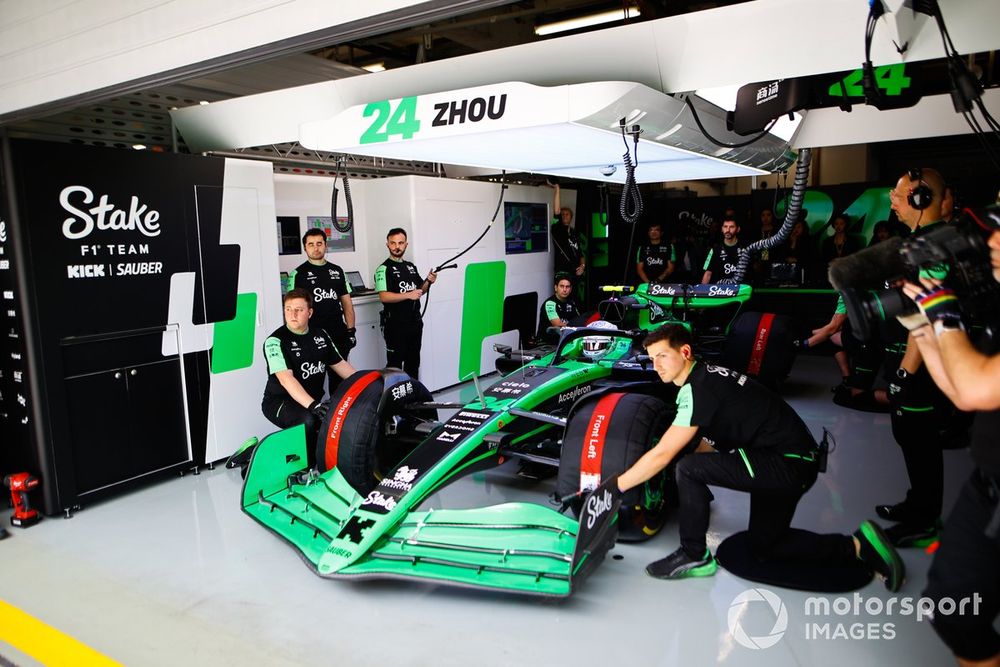F1 News
F1 Chinese Grand Prix: Its Chaotic Revival and Cloudy Future
Online ticket sales for the 2024 Chinese Grand Prix launched at 8 p.m. China Standard Time on January 9th of this year, and by 8:01 the operation was in trouble. Overloaded servers wreaked havoc on a system designed to link pre-ordered tickets with either a national ID or an international passport, blocking buyers who thought they had already, in some ways, won the lottery. Chaos and frustration ensued. “There was such a backlash online as to how JUSS Sports, the ticket sales promoter, messed it up so badly,” says Zhou Haoran, F1 Guest Commentator at Shanghai Sports TV. But it’s not entirely surprising that technology crumbled in the face of a historic moment.
This weekend the dam breaks on five years of pent-up excitement around the Chinese Grand Prix, its first running since 2019. The country’s strict zero-Covid policy made hosting a Formula One race weekend impossible until the rule’s cancellation in 2022—by which time it was too late to secure Shanghai’s place in the schedule for 2023.
It's not just the return of the race, it's also Zhou Guanyu. The 24-year-old driver for Kick Sauber is the first-ever Chinese driver to race in Formula 1, representing a country whose motorsports history isn’t much older than he is. The Zhou Effect—on those fried-server ticket sales, on motorsports in China, on Formula 1 building a fanbase in the country—is real. Though he’s currently in a six-way tie for 15th place in the driver standings, with zero points, none of that matters, because 2024 will be his first time running the Chinese GP. When the green flag drops on Saturday (for the sprint race), he’ll do something no countryman has done before.
It’s not impossible that this could also be one of his last moments driving Shanghai’s course, too.
That’s because the future of the Chinese GP hangs in the balance, with a contract set to end after 2025 and a track that seems increasingly flawed for Formula 1 racing. For a race with an uncertain fate, a melted server is a cause for celebration—for both the race itself, and the country's nascent motorSports fandom. But will it be enough?
Racing On the Sea
It’s been a long road, but a short three decades, to where motorsports exist today in China. Into the 1980s, private car ownership was nearly impossible. No surprise, then, that motorsports didn’t really land in the country until its citizens had a chance to fall in love with cars. The spark began when a street-circuit race in Zhuhai, a city in the south of China bordering the then-Portuguese colony of Macau, began in 1993. Three years later, a permanent race circuit opened up in the city, and soon after China brokered the addition of a provisional Formula One race for the 1999 schedule.
Then the FIA backed out, claiming that the Zhuhai International Circuit, didn’t meet the governing body’s standards, despite being built with Formula 1 in mind. Rather than try to re-engineer the track, China looked to its most populous city, Shanghai. Specifically, a site in the Jiading District about 25 miles (40 kilometers) north of the city center.
Taking no chances, designer Hermann Tilke (whose latest credits include Jeddah Corniche Circuit in Saudi Arabia and the Las Vegas Street Circuit in the U.S.) was hired to architect the 3.39 mile-long (5.45 km) track and facilities to met FIA demands, terraforming swampland into a pristine race course. Work began in 2003, and—with the help of 2.6 billion yuan (about $315 million dollars at the time) and 3,000 workers—finished in time for the inaugural China Grand Prix in 2004. The track’s shape is even something of a showcase: “Shanghai” translates to “on the sea,” and from the air, circuit intentionally resembles the first Chinese character in Shanghai: 上 (shang), which means “above.”
That first Formula 1 race at Shanghai international Circuit sold out, drawing 200,000 people. “It was a full house for several reasons,” says Zhou Houran. “Firstly, Formula One was being billed as the third largest sporting event, after the World Cup and the Olympics. At that time the Chinese people had the thought that F1 is a lot bigger than it actually is. Secondly, it was at the height of the Ferrari domination, and Chinese people love Ferrari, period. They like a hero, and Schumacher was as big a hero as you can get.”
Sellout crowds haven’t been as easy to come by for the Chinese Grand Prix since that inaugural race. The last great attendance would have been 2006, for Michael Schumacher’s retirement season. Zhou believes the race suffered again when Kimi Räikkönen retired from Formula One in 2009. Turns out Raikonnen had a big following in China—particularly among female fans.
“After 2009 it was difficult for Chinese fans to get excited about the race [because] they didn’t know who to cheer for,” says Zhou Houran. “They don’t like the domination of Red Bull—the team just doesn’t create the same fan base in China. And so over time, the circuit actually took down grandstands.”

Zhou Guanyu in the Kick Sauber C44 ahead of the 2024 Chinese GP
Photo by: Andy Hone / Motorsport Images
Green Flag or Checkered Flag?
Formula 1's presence in China was born with a cloud over its head, and wild as it seems given the allure of winning over a nation of 1.4 billion people, it hasn’t shaken an ominous sense of impermanence. For one, the Chinese GP’s current contract with the FIA expires with next year’s race. In 2002 China bid then-exorbitant fees to capture a slot on the F1 calendar; later, mounting losses led to a reduced fee for the 2011 extension. Leading into this year, the track itself needed to be aggressively resurfaced—its swampland-induced bumpiness and poor surface were set to cause havoc on the newer ground effect designs. (And the latest news isn't inspiring confidence: the track surface appears to have been painted in advance of this weekend's race.)
Counterbalancing it all is the Zhou Effect. The ticket server meltdown, frustrating as it must have been for the fans, may have been just the proof that the Chinese Grand Prix’s future deserves to be secured. Motorsports, particularly F1, clearly has a fan base in China. Especially as more Chinese drivers ascend the ranks across motorsports, bringing accolades and eager young newcomers into the fold.
While Zhou Guanyu will almost certainly be the first Chinese driver to race in Formula 1 when the lights go out on Saturday's sprint race, he’s not the first Chinese driver to take part in Formula One. That title belongs to Ma Qinghua, who entered the history books when he drove in the Friday practice session of the 2012 Italian Grand Prix, having joined the HRT F1 driver development program.
“I just chose the right moment, the right series, and managed to achieve success,” remembers Ma. He’s since gone on to considerable success in the TCR World Tour, currently driving with Cyan Racing, the official partner to Geely Group Motorsport. Geely, not coincidentally, runs the Geely Super Cup championship. Open to the general public, it bridges the divide between amateur and professional drivers by adding teams and professional team managers. And it gives Chinese motorSports fans a chance to join the action—including starting a career behind the wheel.
“We have Zhou Guanyu in F1, myself in the TCR World Tour, and Ye Yifei in WEC,” explains Ma. “There are a lot of active young drivers in go-kart championships around the world. As the national series have gotten stronger, I think it is very positive for the whole industry.” It’s one thing to enjoy motorsports, and another to see yourself as part of them.
No matter which position Zhou Guanyu takes this Sunday, the crowd will be roar for the Shanghai native. (Though for the fun of it, let yourself imagine the joyful insanity that would erupt at the track if he somehow stood on the podium.) It’s not impossible that somewhere in the crowd will be a young boy or girl who, inspired by Zhou, begins a career that takes them into the Chinese motorsport record books, too. Hopefully at their home track.
-

 F1 News1d ago
F1 News1d agoRB reveals “chameleon” F1 Miami GP livery
-

 F1 News1d ago
F1 News1d agoVettel to drive Senna's 1993 McLaren in F1 Imola tribute
-

 F1 News1d ago
F1 News1d agoThe dilemma faced by players in F1's "uncomfortably early" driver carousel
-

 F1 News1d ago
F1 News1d agoNewey free to join F1 rival in 2025, Red Bull warned of “unmitigated disaster”
-

 F1 News2d ago
F1 News2d agoGuenther Steiner takes Haas F1 team to court
-

 F1 News2d ago
F1 News2d agoWhy a Monaco tyre test could help spice up F1 races elsewhere
-

 F1 News2d ago
F1 News2d agoAston Martin requests right of review for Alonso's China F1 penalty
-

 F1 News2d ago
F1 News2d agoAdrian Newey's Red Bull F1 departure imminent

























